Like many martial arts, BJJ uses different coloured belts to distinguish between the various levels of skill. While some schools have specific curricula they follow and test on, most do not. What tends to be distinct in BJJ is that generally belts are awarded based on skill. Commercialized traditional martial arts schools have developed a reputation for having black belts who were able to perform the techniques needed to pass a belt test, but could not handle themselves in actual sparring or a real self defence situation. Jiu-Jitsu is known for its consistency across belts, even if there is wide variation when we take things like athleticism, age, training frequency and more into account,. Each belt is a significant milestone because it represents real growth. As it can take so long in between belts, generally years, many schools use stripes as benchmarks along the way to the next belt. Some even use a separate belt — sometimes several in between white and blue — though generally not after blue belt. Each school handles belt promotions differently, but they all take them seriously.
White Belt
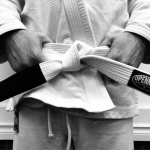 The most important belt — the beginning of one’s journey. At this level, depending on the school’s focus, one typically learns the fundamentals of self-defence, movement and the theory behind BJJ. Often there are separate classes for white belts, and sometimes even have different classes for brand new white belts and experienced white belts. This is a long, fun, challenging part of the journey where you will be learning to speak the language of Jiu-Jitsu. One key difference between white belt and blue belt is yes, skill difference, but that skill is based on a strong conceptual understanding, which is why this book was written. These concepts are rarely taught, more often absorbed through osmosis over time. Blue belts are often quite composed, whereas white belts too often “spaz out”, not calibrating a roll and rolling too roughly. The key is to remain calm, slow down and try to apply your techniques with as little muscle as possible. Note: in recent years, many schools have incorporated a Green or other “in-between” belt so that students do not have to wait quite so long before earning their first coloured belt.
The most important belt — the beginning of one’s journey. At this level, depending on the school’s focus, one typically learns the fundamentals of self-defence, movement and the theory behind BJJ. Often there are separate classes for white belts, and sometimes even have different classes for brand new white belts and experienced white belts. This is a long, fun, challenging part of the journey where you will be learning to speak the language of Jiu-Jitsu. One key difference between white belt and blue belt is yes, skill difference, but that skill is based on a strong conceptual understanding, which is why this book was written. These concepts are rarely taught, more often absorbed through osmosis over time. Blue belts are often quite composed, whereas white belts too often “spaz out”, not calibrating a roll and rolling too roughly. The key is to remain calm, slow down and try to apply your techniques with as little muscle as possible. Note: in recent years, many schools have incorporated a Green or other “in-between” belt so that students do not have to wait quite so long before earning their first coloured belt.
Blue Belt
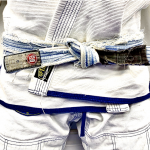 A serious achievement, Blue Belt represents the base-level player — one who has not only persevered through the trials and tribulations of training, but has developed a solid level of skill in each of the basic positions and is able to defend themselves against a bigger, stronger, faster person. At this level, one will refine what they know and continue to add to it. If white-blue was about learning to survive, escape, control and attack from the four basic positions, Blue Belts focus on the same goals for a much wider swath of positions including Turtle, North/South, Knee on Belly and more, including a wide variety of guard positions. One of the dangers of earning a blue belt is that it can feel like it took so much time and energy, that now the climb to purple, brown and black is just too intimidating, causing many to quit — the “blue belt curse”. Just focus on where you need to improve now, rather than focus on the belt — keep plugging your holes and you develop something solid.
A serious achievement, Blue Belt represents the base-level player — one who has not only persevered through the trials and tribulations of training, but has developed a solid level of skill in each of the basic positions and is able to defend themselves against a bigger, stronger, faster person. At this level, one will refine what they know and continue to add to it. If white-blue was about learning to survive, escape, control and attack from the four basic positions, Blue Belts focus on the same goals for a much wider swath of positions including Turtle, North/South, Knee on Belly and more, including a wide variety of guard positions. One of the dangers of earning a blue belt is that it can feel like it took so much time and energy, that now the climb to purple, brown and black is just too intimidating, causing many to quit — the “blue belt curse”. Just focus on where you need to improve now, rather than focus on the belt — keep plugging your holes and you develop something solid.
Purple Belt
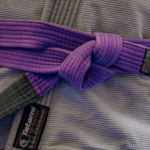 The first “advanced” belt, purple belt represents the specialist. With all of the fundamentals of a blue belt, the purple belt can really “speak” Jiu-Jitsu and has started to define their game — their specific techniques, combinations and strategies that are unique to them. In addition to having developed a signature game, purple belts typically have developed a high level of timing, finesse and, depending on the style of training, grace. In some more aggressive, competitive schools, rather than being graceful, purple belts are simply tough. Being able to impose their will, they relentlessly drive through obstacles. At this level, one continues to round out their game, experimenting with new techniques and strategies.
The first “advanced” belt, purple belt represents the specialist. With all of the fundamentals of a blue belt, the purple belt can really “speak” Jiu-Jitsu and has started to define their game — their specific techniques, combinations and strategies that are unique to them. In addition to having developed a signature game, purple belts typically have developed a high level of timing, finesse and, depending on the style of training, grace. In some more aggressive, competitive schools, rather than being graceful, purple belts are simply tough. Being able to impose their will, they relentlessly drive through obstacles. At this level, one continues to round out their game, experimenting with new techniques and strategies.
Brown Belt
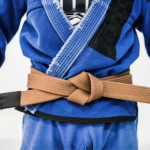 An elite player. By brown belt, one has developed a high level of awareness, precision, timing and physical and mental toughness. Able to impose their game on others, they are well-rounded with specialties in a number of areas. Closer to black belt than purple is to brown, the brown belt is somewhat “complete” as a martial artist, having developed systems of escapes, crushing heaviness, smooth movement and an interconnectedness between their entire game. At this level, the typical brown belt tends to “get back to basics”, refining their fundamentals and plugging any holes in their games. Those focused specifically on competition tend to seek out ever-more effective ways to impose their games, while studying top players and opponents, seeking to break down and analyze their tactics.
An elite player. By brown belt, one has developed a high level of awareness, precision, timing and physical and mental toughness. Able to impose their game on others, they are well-rounded with specialties in a number of areas. Closer to black belt than purple is to brown, the brown belt is somewhat “complete” as a martial artist, having developed systems of escapes, crushing heaviness, smooth movement and an interconnectedness between their entire game. At this level, the typical brown belt tends to “get back to basics”, refining their fundamentals and plugging any holes in their games. Those focused specifically on competition tend to seek out ever-more effective ways to impose their games, while studying top players and opponents, seeking to break down and analyze their tactics.
Black Belt
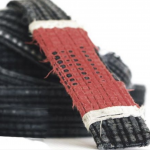 A new beginning. Most look at black belt as an end, but as BJ Penn once put it “there are black belts and then there are black belts”, when comparing himself to the legendary Rigan Machado. “You can be a “blue belt black belt” or a “black belt black belt” — a new black belt like himself compared with a legend of the art.” To earn a black belt in BJJ, one has to have persevered through years of hard training, wins and losses, beliefs and doubts and challenges of all kinds. The black belt can survive, defend and escape every situation, while being able to dominate others with precision, pressure and efficiency. At this level, one continues to explore, deepen and evolve the art, adding their own flavour and flare, often while continuing to share it with others.
A new beginning. Most look at black belt as an end, but as BJ Penn once put it “there are black belts and then there are black belts”, when comparing himself to the legendary Rigan Machado. “You can be a “blue belt black belt” or a “black belt black belt” — a new black belt like himself compared with a legend of the art.” To earn a black belt in BJJ, one has to have persevered through years of hard training, wins and losses, beliefs and doubts and challenges of all kinds. The black belt can survive, defend and escape every situation, while being able to dominate others with precision, pressure and efficiency. At this level, one continues to explore, deepen and evolve the art, adding their own flavour and flare, often while continuing to share it with others.
Beyond Black Belt — Degrees, Coral and Red Belts
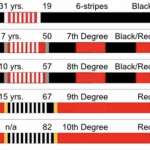 Progress (in rank) beyond black belt is determined by time in the art. The first three stripes or degrees after black belt require a minimum of three years each, while 4th, 5th and 6th degrees require five years in between. At the 7th degree, awarded after a minimum of seven years at 6th degree, Black Belts are awarded their red and black, coral belt. Their 8th degree is awarded after a minimum of 7 years as a coral belt and comes with a red and white coral belt. After ten years at 8th degree, one becomes a 9th degree and is awarded their red belt. 10th degree is reserved for the original Gracie brothers who founded BJJ, namely Carlos, Helio, George, Oswaldo and Gastao Gracie.
Progress (in rank) beyond black belt is determined by time in the art. The first three stripes or degrees after black belt require a minimum of three years each, while 4th, 5th and 6th degrees require five years in between. At the 7th degree, awarded after a minimum of seven years at 6th degree, Black Belts are awarded their red and black, coral belt. Their 8th degree is awarded after a minimum of 7 years as a coral belt and comes with a red and white coral belt. After ten years at 8th degree, one becomes a 9th degree and is awarded their red belt. 10th degree is reserved for the original Gracie brothers who founded BJJ, namely Carlos, Helio, George, Oswaldo and Gastao Gracie.

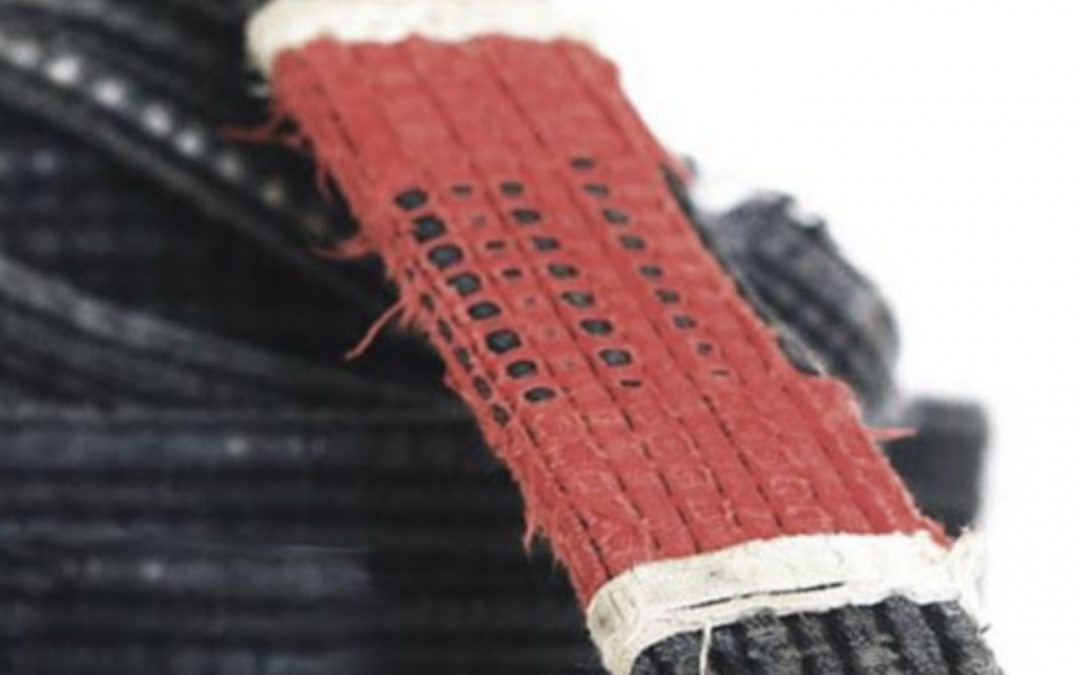
Recent Comments